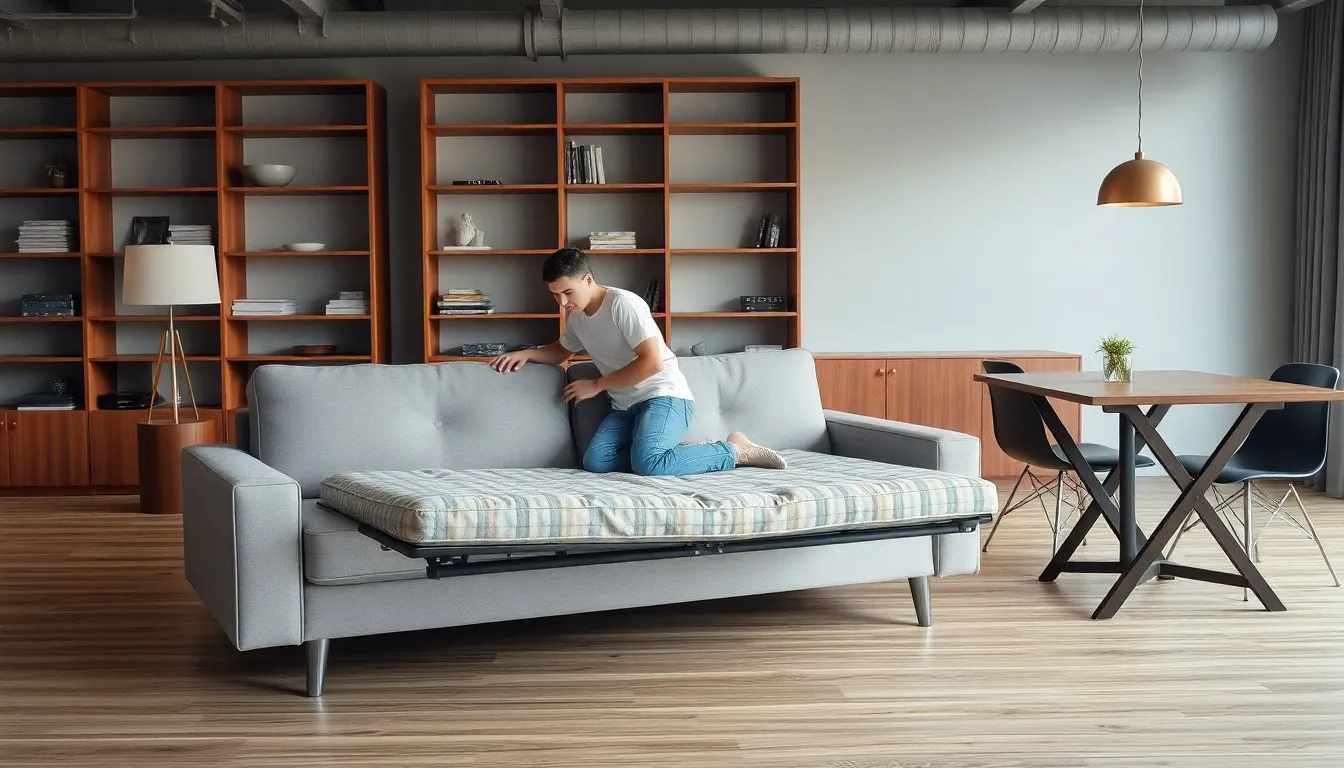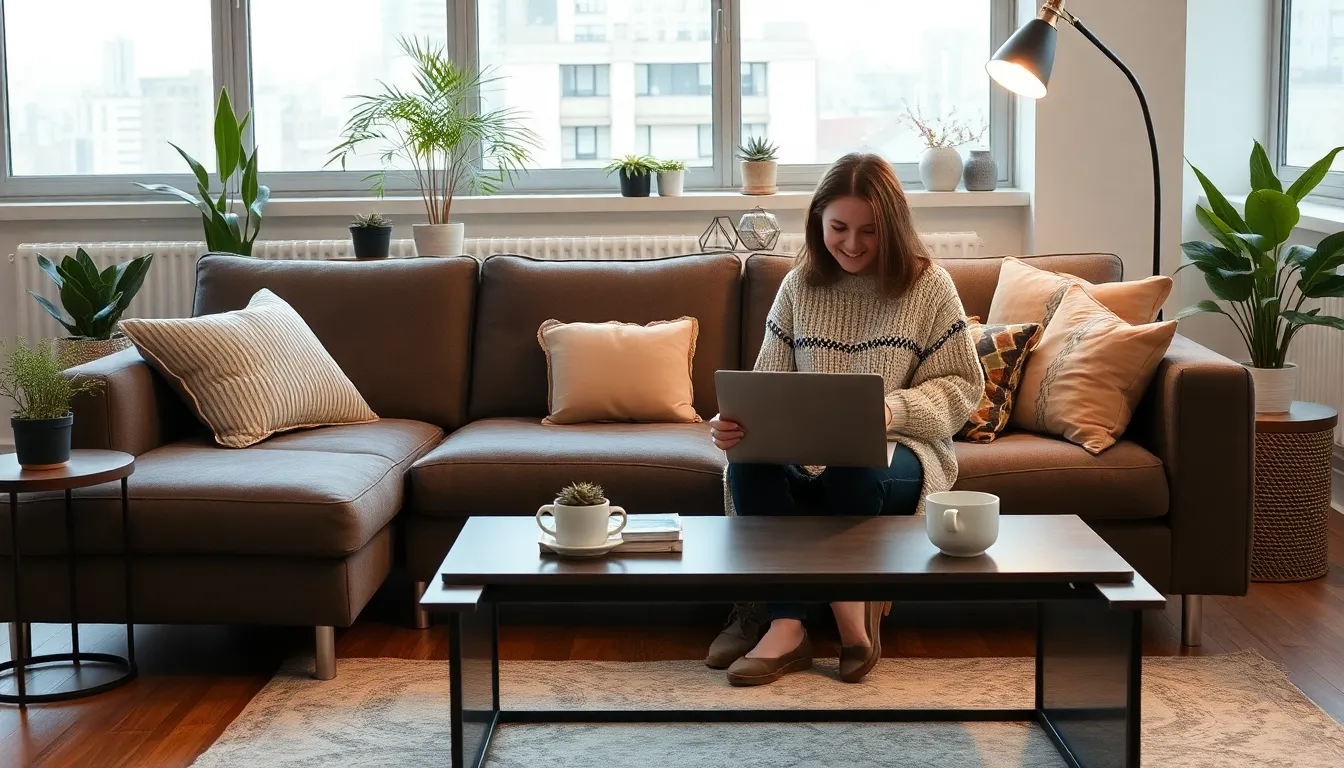Table of Contents
ToggleIn a world where space often feels like a luxury, multi-functional furniture swoops in like a superhero ready to save the day. Imagine a coffee table that transforms into a dining table or a sofa that morphs into a bed faster than you can say “where did I put my keys?” These versatile pieces not only maximize space but also add a dash of style to any room.
Gone are the days of sacrificing comfort for practicality. With multi-functional furniture, you can have your cake and eat it too—just make sure it’s not sitting on your new ottoman! This clever furniture is perfect for small apartments, home offices, or anywhere that could use a little extra room. Get ready to discover how these innovative designs can revolutionize your living space while keeping your sense of humor intact.
What Is Multi-Functional Furniture?
Multi-functional furniture refers to versatile pieces designed to serve multiple purposes. Items like sofa beds provide seating that easily transforms into a sleeping area, making them especially useful in compact spaces. Coffee tables that convert into dining tables maximize utility in small living rooms, allowing for flexibility during gatherings.
Designers create these innovative solutions to harmonize functionality and aesthetics. Features such as hidden storage compartments enhance practicality, enabling homeowners to keep their spaces organized. Ultimately, this furniture type appeals to individuals seeking to streamline their living areas or accommodate various activities in limited square footage.
Constructing environments that accommodate work, relaxation, and socialization proves increasingly necessary in modern homes. Furniture styles, like modular sofas, allow users to reconfigure their setups based on their needs. Likewise, extendable dining tables make hosting versatile, providing the option to narrow or broaden surface areas with ease.
Multi-functional furniture suits diverse lifestyles. Families benefit from durable pieces that adjust as needs change, while single professionals enjoy the practicality of adaptable design. Each versatile item contributes to an efficient and stylish living environment.
Prioritizing efficient use of space aligns with current design trends. As people seek comfort without sacrificing style, multi-functional furniture emerges as a favored solution. Integrating these designs into homes simplifies daily living while enhancing overall ambiance.
Benefits of Multi-Functional Furniture

Multi-functional furniture offers numerous advantages, particularly in optimizing living spaces. This type of furniture enhances the overall functionality of homes.
Space Efficiency
Space efficiency remains a primary benefit of multi-functional furniture. These pieces minimize clutter by combining multiple functions. For example, a sofa bed provides a seating area during the day and transforms into a sleeping space at night. Modular systems allow for configuration changes based on needs. With urban areas growing more populated, the demand for efficient designs continues to rise. Utilizing vertical space through shelving units that double as room dividers helps maximize usable areas in compact apartments.
Cost-Effectiveness
Cost-effectiveness is another significant advantage of multi-functional furniture. Investing in versatile pieces reduces the need for multiple items, saving money over time. A foldable dining table can serve for meals and workspace, eliminating the purchase of separate desks. Retailers increasingly offer affordable options to accommodate various budgets. Budget-conscious individuals appreciate the long-term savings these investments offer, enhancing overall satisfaction. Families and professionals alike find that multi-functional items help stretch purchase power while maintaining a stylish aesthetic.
Versatility
Versatility highlights the adaptability of multi-functional furniture. These designs cater to diverse lifestyles and needs effectively. A storage ottoman functions as both seating and space for blankets or books. Extendable dining tables accommodate different numbers of guests with ease. As work-from-home trends continue, these pieces also serve as efficient workstations. Many consumers embrace pieces that can pivot between relaxation, entertainment, and productivity. As modern living spaces evolve, having versatile options creates a seamless transition between activities.
Popular Types of Multi-Functional Furniture
Multi-functional furniture encompasses a variety of innovative designs tailored for optimized space usage. Several popular types cater to diverse needs and environments.
Sofa Beds
Sofa beds serve as the ultimate space-saving solution. They provide comfortable seating during the day and convert into a bed for overnight guests. Many modern sofa beds feature sleek designs that blend well with various decor styles. Durability is key, ensuring that they withstand regular use. Additional features may include built-in storage, maximizing functionality while keeping rooms tidy.
Folding Tables
Folding tables stand out for their versatility. These tables easily transition from a compact size to a full-size dining or workspace, accommodating guests or activities as needed. They’re often lightweight, allowing for effortless transport or storage when not in use. Some designs incorporate adjustable heights to further enhance function. This adaptability makes folding tables ideal for both tight areas and larger gatherings.
Storage Ottomans
Storage ottomans combine style with practicality. They function as comfortable footrests or extra seating, while also offering hidden storage inside. Perfect for stashing blankets, magazines, or toys, these ottomans help maintain a clutter-free environment. Many designs come in various colors and textures, allowing for seamless integration into any room’s aesthetic. Choosing a storage ottoman adds both flair and functionality to spaces.
Tips for Choosing Multi-Functional Furniture
Choosing the right multi-functional furniture involves careful consideration of several factors. Understanding space requirements and personal needs boosts the effectiveness of your selection.
Assess Your Space
Evaluating available space is crucial. Measure dimensions of rooms, noting the layout and flow. Consider ceiling height, doorways, and existing furniture arrangements. Recognizing these aspects helps avoid overcrowding. Visualizing how items will fit promotes seamless integration into the overall design. Smaller pieces optimize tight areas while larger, adaptable options work well in expansive spaces. Using 3D room planner tools aids in visualizing furniture placement. Prioritize styles that maintain balance and functionality to ensure the environment feels open and inviting.
Consider Your Needs
Identifying personal lifestyle needs shapes furniture choices. Determine activities that occur in your living space, such as entertaining, working, or relaxing. Understanding how often each function is utilized guides decisions. For those frequently hosting guests, a sofa bed serves dual purposes, accommodating overnight visitors. Families with children may prefer rugged materials that withstand wear and tear. Consider pieces with built-in storage that minimize clutter while maximizing usability. Each need contributes to a cohesive approach in selecting multi-functional options that adapt over time. Prioritizing practicality aligns selections with daily life.
Maintenance and Care
Regular maintenance keeps multi-functional furniture in top condition, ensuring longevity and functionality. Cleaning surfaces with mild soap and water prevents dirt buildup; this works well for wood, fabric, and metal pieces.
Inspecting joints and hinges regularly prevents wear and tear. Tightening screws or brackets as needed can maintain stability, particularly in foldable or convertible designs.
Conditioning wood furniture every six months preserves its finish and prevents cracking. It’s essential to follow manufacturer recommendations regarding care products for specific materials.
Avoiding exposure to direct sunlight protects fabrics from fading. For pieces with storage compartments, routinely check for items that may accumulate dust or debris.
Using coasters and placemats preserves surfaces from scratches and heat damage. Encouraging proper weight distribution on convertible sofa beds ensures the mechanisms work smoothly and reduces strain over time.
Vacuuming upholstered furniture every few weeks maintains cleanliness and prevents allergens from accumulating. Spot cleaning stains immediately can prevent them from setting, particularly on light-colored fabrics.
Rotating cushions periodically promotes even wear and maintains shape. Addressing any damage promptly prevents further deterioration, ensuring the pieces remain functional and visually appealing.
Understanding the specifics of materials used enhances care strategies, and following these guidelines can optimize the lifespan of multi-functional furniture pieces. Efforts in maintenance translate to a lasting investment in both style and utility.
Multi-functional furniture stands out as a practical solution for modern living. Its ability to maximize space while adding style makes it an essential choice for those navigating smaller homes or versatile work environments. With innovative designs that prioritize both aesthetics and functionality, these pieces adapt to various lifestyles seamlessly.
Investing in multi-functional furniture not only enhances the overall look of a space but also promotes efficiency and cost savings. As urban living continues to evolve, embracing these versatile solutions will ensure that homes remain comfortable and organized. Proper maintenance further extends the life of these investments, allowing individuals to enjoy their benefits for years to come.



